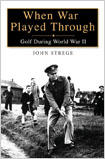Author: John Strege
Title: When War Played Through: Golf During World War II
Publisher: Gotham Books
Price: $26
ISBN: 1-592-40154-6

World War II was a calamitous event that dramatically changed everything—even the game of golf. John Strege’s When War Played Through: Golf During World War II profiles golf’s impact on the war effort and effectively catalogs the challenges the sport faced in maintaining its public image during difficult times.
Unlike major league baseball, which continued throughout the war at the insistence of President Franklin D. Roosevelt, golf in the U.S. took a hiatus from 1942-45, its officials “stepping away from their elitist traditions on behalf of the greater good. It was a defining moment for golf and for those governing it, who acknowledged without reluctance--some, perhaps for the first time--that as Americans they were all in this together.“
Instead, through the efforts of the game’s greats (e.g., Bobby Jones, Ben Hogan, Sam Snead and Byron Nelson) and entertainers like Bob Hope and Bing Crosby, golf became a key source of fundraising and morale-boosting, and even a form of occupational therapy for wounded GIs (which helped spur the sport’s postwar boom as a more plebeian pursuit). As Strege tells it, Jones and Hogan took more active roles as soldiers in the U.S. Army Air Corps. Snead, while enlisted, mostly spent his time in the service teaching soldiers how to play the game--and filling out foursomes with officers honored to have his company. Nelson, 4-F due to a rare but non-life-threatening blood disorder, had the distinction (and good fortune) of spending his war years playing exhibition matches for war bonds.
Strege ranges widely over people, places (both home and abroad), and episodes great and small, recounting rubber shortages that affected the supply of golf balls; the untoward use of prestigious venues like Augusta National for military training and also for Victory gardens and grazing pasture; and even the strange occurrence of Allied POWs building a makeshift golf course at Stalag Luft III, site of events that inspired the film The Great Escape. (Yes, the enterprising, boredom-challenged prisoners had to fashion their own clubs and balls, and Strege even tells us how they did it.)
The author, a frequent contributor to Sports Illustrated, Golf, and Golf World (and also the author of the best-seller Tiger), weaves in brief tales concerning golf aficionado General Dwight D. Eisenhower, whose well-known affection for the game found more prominent exposure after he became U.S. president in 1953. Strege also proffers a little history about the Bush clan in the person of Prescott Bush, the current president’s grandfather, who was an avid, 2-handicap golfer, and who served during the war as national campaign chairman of the USO and also chair of the National War Fund, which oversaw some 600 war relief groups. (Another tidbit: golf’s Walker Cup is named for the current president’s maternal great-grandfather.)
More poignantly, Strege relates the stories of promising young golfers (e.g., Georgetown University’s John Burke) who made the ultimate sacrifice for their country. He further clarifies the long-held but incorrect notion that Pearl Harbor’s military and naval chiefs, Lt. General Walter C. Short and Admiral Husband E. Kimmel, were on a fairway when the Japanese planes began their attack. They weren’t. However, they were getting ready to play a scheduled round, and if the attack had come an hour later, a bomb on the 5th Hole green might’ve killed them both.
Concluding chapters offer an overview of the game’s postwar “return to normalcy,” highlighted by the irrepressible Nelson’s unprecedented 11 consecutive PGA victories and the surprise 1946 Masters victory of lesser-known golfer Herman Keiser, who had served as a sailor on the USS Cincinnati .
Strege is a strong, stylish writer, and he deftly manages to develop what, at first glance, might seem to be a rather arcane subject. He puts just enough back-spin on the history to make the golf lore come alive. His book is recommended highly for those golf fans whose broader interests lie beyond the 19th hole.
No comments:
Post a Comment